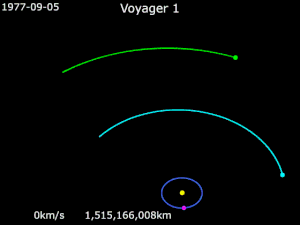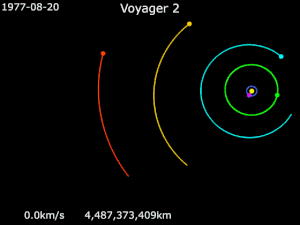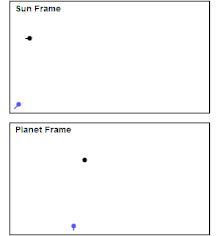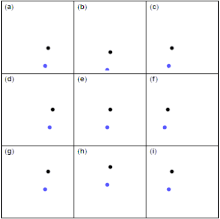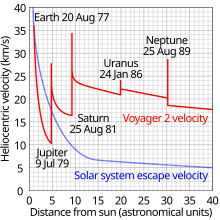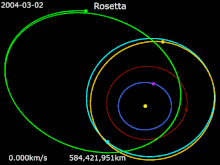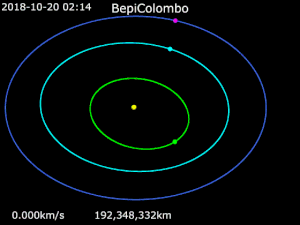 SpaceX Starship prototype SN9 on the pad in Boca Chica, Texas, January 2021 | |
| Function | |
|---|---|
| Manufacturer | SpaceX |
| Country of origin | United States |
| Cost per launch | US$2 million (aspirational and eventual) |
| Size | |
| Height | 120 m (390 ft) |
| Diameter | 9 m (30 ft) |
| Mass | 5,000 t (11,000,000 lb), estimate incl. max. payload |
| Stages | 2 |
| Capacity | |
| Payload to low Earth orbit | |
| Mass | 100–150 t (220,000–330,000 lb) |
| Volume | 1,100 m3 (39,000 cu ft) |
| Payload to geostationary transfer orbit | |
| Mass |
|
| Payload to Moon | |
| Mass | 100–200 t (220,000–440,000 lb), HLS with refueling |
| Payload to Mars | |
| Mass | 100–150 t (220,000–330,000 lb) (with multiple refuelling) |
| Associated rockets | |
| Family | SpaceX launch vehicles |
| Comparable | |
| Launch history | |
| Status | In development |
| Launch sites | |
| First stage – Super Heavy | |
| Length | 70 m (230 ft) |
| Diameter | 9 m (30 ft) |
| Propellant mass | 3,400 t (7,500,000 lb) |
| Engines | 29 then 33 Raptors |
| Thrust | c. 74 MN (7,500 tf; 17,000,000 lbf) |
| Specific impulse | 330 s (3.2 km/s) |
| Propellant | Subcooled CH 4 / LOX |
| Second stage – Starship | |
| Length | 50 m (160 ft) |
| Diameter | 9 m (30 ft) |
| Empty mass | 120 t (260,000 lb), goal |
| Gross mass | 1,320 t (2,910,000 lb) |
| Propellant mass | 1,200 t (2,600,000 lb) |
| Engines | 6 Raptors |
| Thrust | c. 14 MN (1,400 tf; 3,100,000 lbf) |
| Specific impulse | 380 s (3.7 km/s), vacuum |
| Propellant | Subcooled CH 4 / LOX |
The Starship system is a fully reusable, two‑stage‑to‑orbit super heavy‑lift launch vehicle under development by SpaceX. The system is composed of a booster stage named Super Heavy and a second stage, also called "Starship". Unusually for a traditional launch vehicle second stage, the Starship second stage is being designed to be a long‑duration cargo and passenger‑carrying spacecraft and lander.
Starship system vehicle development began in 2016 as a self‑funded private spaceflight project, four years after work began on the Raptor rocket engine that powers both stages. Flight testing of the Starship second stage began in 2019 with low-velocity launches and landings, and extended through high-altitude descent tests into May 2021, when Starship SN15 became the first prototype to successfully complete a high-altitude test flight and be recovered. As of June 2021, SpaceX is planning an orbital test flight of an entire two-stage Starship system by September 2021.
The Starship system is designed to carry passengers and cargo to destinations including low Earth orbit, the Moon, and Mars. It is an integral part of SpaceX's mission to establish a permanent human presence on Mars. Both the Starship upper stage and the Super Heavy booster stage are constructed with a stainless steel hull 9 m (30 ft) in diameter.
In April 2020, NASA selected a modified Starship system as one of three potential lunar landing system design concepts to receive funding for a 10‑month‑long initial design phase for the NASA Artemis program. On 16 April 2021, NASA contracted SpaceX to develop a modified crew-rated Starship vehicle to serve as the lunar lander in the Artemis program.
Nomenclature
The name of the vehicle changed many times after its first announcement and during the first several years of development. At least as early as 2005, SpaceX used the codename "BFR" for a conceptual heavy‑lift launch vehicle, "far larger than the Falcon family of vehicles", with a goal of 100 tonnes (110 tons) to orbit. Beginning in mid‑2013, SpaceX referred to both the mission architecture and the vehicle as "Mars Colonial Transporter". By the time a large 12-meter (39 ft) diameter design concept was unveiled in September 2016, SpaceX had begun referring to the overall system as the Interplanetary Transport System.
With the announcement of a new 9-meter (30 ft) design in September 2017, SpaceX resumed referring to the vehicle as "BFR", with SpaceX CEO Elon Musk stating "we are searching for the right name but the code name, at least, is BFR". SpaceX President Gwynne Shotwell subsequently stated that BFR stands for "Big Falcon Rocket". However, Musk had explained in the past that although BFR is the official name, he drew inspiration from the BFG weapon in the Doom video games. The BFR had also occasionally been referred to informally by the media and internally at SpaceX as "Big Fucking Rocket". At the time, the second stage/spacecraft was referred to as "BFS" (Big Falcon Ship or Big Fucking Ship). The booster's first stage was also at times referred to as the "BFR" (Big Falcon Rocket or Big Fucking Rocket).
In November 2018, the second stage/spaceship was renamed Starship and the first stage booster was renamed Super Heavy. The entire system (first stage booster plus second stage/spaceship) is also sometimes referred to collectively as "Starship". The combination of Starship spacecraft and Super Heavy booster is also called the "Starship system" by SpaceX in their payload user's guide. The term "Super Heavy" had also been previously used by SpaceX in a different context. In February 2018, at about the time of the first Falcon Heavy launch, Musk had suggested the possibility of a Falcon Super Heavy—a Falcon Heavy with extra boosters.
History
The launch vehicle was initially mentioned in public discussions by Musk in 2012 as part of a description of the company's overall Mars system architecture, then known as "Mars Colonial Transporter" (MCT). By August 2014, media sources speculated that the initial flight test of the Raptor‑driven super‑heavy launch vehicle could occur as early as 2020, to fully test the engines under orbital spaceflight conditions; however, any colonization effort was then reported to continue to be "deep into the future".
In mid‑September 2016, Musk noted that the Mars Colonial Transporter name would not continue, as the system would be able to "go well beyond Mars" and that a new name would be needed. The name selected was "Interplanetary Transport System" (ITS). In September 2017, at the 68th annual meeting of the International Astronautical Congress, SpaceX unveiled an updated vehicle design.
In September 2018 Musk showed another redesigned concept for the second stage and spaceship with three rear fins and two front canard fins added for atmospheric entry, replacing the previous delta wing and split flaps shown a year earlier. He also announced a planned 2023 lunar circumnavigation mission, a private spaceflight called dearMoon project. The two major parts of the launch vehicle were given descriptive names in November 2018: "Starship" for the upper stage and "Super Heavy" for the booster stage, which Musk pointed out was "needed to escape Earth's deep gravity well (not needed for other planets or moons)".
In January 2019, Musk announced that Starship would no longer be constructed out of carbon fiber and that stainless steel would be used instead, citing several reasons including cost, strength, and ease of production. Later in May SpaceX changed the Starship design back to using just six Raptor engines, with three of the engines optimized for sea‑level and three optimized for vacuum. Later that month, an initial test article, Starhopper, was being finished for untethered flight tests at the SpaceX South Texas launch site, while two "orbital prototypes" without aerodynamic control surfaces were under construction, one in South Texas and one on the Florida Space Coast. The following month, SpaceX publicly announced that discussions had begun with three telecommunications companies for using Starship, rather than Falcon 9, for launching commercial satellites in 2021. No specific companies or launch contracts were announced at that time.
Starhopper made two flights in July 2019, first to an altitude of 20 m (66 ft), and then to 150 m (490 ft). In September 2019, Musk unveiled Starship Mk1, a more advanced test article. Mk1 was destroyed in a tank pressure test that November. SpaceX subsequently abandoned the Mk2 prototype and moved on to Mk3.
Adopting a new "serial number" nomenclature, the Mk3 prototype was renamed to Starship SN1. In February 2020, Starship SN1 was destroyed during a pressurization test. A stripped-down test tank, Starship SN2, was assembled and pressure-tested successfully. The next prototype, Starship SN3, was destroyed due to a test configuration error in April 2020. Starship SN4 completed a cryogenic proof test on 25 April, and on 5 May, conducted a static fire test with a single Raptor engine. SN4 went on to be used for three more static fire tests (each a few seconds in duration) before it was destroyed in an explosion caused by a post-static-fire propellant leak.
On 4 August 2020 Starship SN5 completed a test flight to an altitude of 150 meters (490 ft), landing at an adjacent landing pad. One month later, SN6 replicated SN5's flight successfully.
By June 2020, Starship development work had become the top SpaceX company priority, except for anything related to a reduction of Crew Dragon return risk for the upcoming Crew Dragon Demo‑2 flight to the ISS, and remained so in September 2020. In September 2020, Musk clarified that SpaceX intended to exclusively fly cargo transport missions initially and that passenger flights would come only much later.
In July 2020, SpaceX procured two deepwater oil rigs from Valaris for $3.5 million each. These semi‑submersible platforms, later renamed Deimos and Phobos (after the two Martian moons), will be modified into two floating platforms for Super Heavy/Starship orbital launches, and eventually, landings. As of January 2021, refit was underway on Deimos at the Port of Brownsville and Phobos at the Port of Galveston.
On 9 December 2020, Starship SN8, the first full-scale Starship prototype fitted with a complement of three Raptor engines as well as body flaps, flew to an altitude of 12.5 km (41,000 ft), performed a horizontal descent, but subsequently failed to complete its landing burn, exploding upon collision with the ground. On 2 February 2021, Starship SN9 attempted a 10 km (33,000 ft) flight, but it too was destroyed upon landing when one of three engines failed to ignite. On 3 March 2021, Starship SN10 successfully landed after a 10 km flight, however, the vehicle was destroyed in an explosion eight minutes later. The next prototype, Starship SN11, launched on 30 March 2021 to an altitude of 10 km, but disintegrated during the landing burn, scattering debris around the launch site. On 5 May 2021, Starship SN15 flew to an altitude of 10 km, landed, and was recovered successfully.
Starship second stage
The upper stage of Starship is intended to function as a second stage to reach orbital velocity on launches from Earth, to be used in outer space as an on‑orbit long‑duration spacecraft as well as an SSTO on launches from Mars, Moon and possibly on other planets or moons. This is in contrast to most previous launch vehicle and spacecraft designs. Starship is being designed to be capable of re-entering Earth's atmosphere from orbital velocities and landing vertically, with a design goal of rapid re‑usability without the need for extensive refurbishment.
According to Musk, when Starship is used for beyond Earth orbit (BEO) launches to Mars, the functioning of the overall expedition system will necessarily include propellant production on the Mars surface. This is necessary for the return trip and to reuse the spaceship to keep costs as low as possible. Lunar destinations (circumlunar flybys, orbits, and landings) will be possible without lunar‑propellant depots, so long as the spaceship is refueled in a high‑elliptical orbit before the lunar transit begins. Some lunar flybys will be possible without orbital refueling as evidenced by the mission profile of the dearMoon project.
General characteristics
As of September 2019, the Starship upper stage is expected to have a 9 m (30 ft) diameter, 50 m (160 ft) tall, capable of being a fully reusable spacecraft with a dry mass of 120 t (120 long tons; 130 short tons) or less, powered by six Raptor engines: three Raptor 2 engines plus three Raptor vacuum engines.
Starship is designed with the ability to re‑enter Earth's atmosphere and retropropulsively land on a designated landing pad. Landing reliability is projected by SpaceX to ultimately be able to achieve "airline levels" of safety due to the ability to fly with one engine not working ("engine‑out capability"). The spacecraft is also designed to be able to perform automatic rendezvous and docking operations and on‑orbit propellant transfer between Starships.
Starship is also designed with the goal to reach other planets and moons in the solar system after on‑orbit propellant loading. While retropropulsion is intended to be used for the final landing maneuver on the Earth, Moon, or Mars, 99.9% of the energy dissipation on Earth reentry is to be removed aerodynamically and on Mars, 99% aerodynamically even with the much thinner Martian atmosphere, where "body flaps" are used to control altitude during descent and optimize both trajectory and energy dissipation during descent.
As envisioned in the 2017 design unveiling, the Starship is to have a pressurized volume of approximately 825 m3 (29,100 cu ft), which could be configured for up to 40 cabins, large common areas, central storage, a galley and a solar flare shelter for Mars missions.
Propulsion
The methane/oxygen‑propellant Raptor engines will be the main propulsion system for both stages of the Starship system. Starship second stage will use three sea‑level optimized Raptor engines and three vacuum‑optimized Raptor engines. The sea‑level engines are planned to be identical to the engines on the Super Heavy booster. Transport use in space is expected to use a vacuum‑optimized Raptor engine variant to optimize specific impulse to approximately 380 s (3.7 km/s; 8,300 mph). Total Starship thrust will be approximately 14 MN (1,400 tf).
Starship is being designed to use pressure fed hot gas reaction control system (RCS) thrusters using methox gas for attitude control, including the final pre‑landing pitch‑up maneuver of the second stage from belly flop to tail down and for stability during high‑wind landings up to 60 km/h (37 mph).[85][86] Initial prototypes have used nitrogen cold gas thrusters, which are substantially less mass efficient but are expedient to support early prototype flight testing.
Variants
Starship is planned to eventually be built in several operational variants, and SpaceX has shown considerable flexibility in adding ship types to handle particular use cases.
- Surface Cargo Starship: a vehicle capable of delivering large payloads to the surface of other celestial bodies. NASA has contracted this Starship variant to land elements on the lunar surface as the CLPS program.
- Orbital Cargo Starship: a vehicle able to transport and place spacecraft into orbit, or handle the in‑space recovery of spacecraft and space debris for return to Earth or movement to another orbit. In the March 2020 users guide, this was shown with a large cargo bay door that can open in space to facilitate delivery and pickup of cargo.
- Tanker: a cargo‑only propellant tanker to support the refilling of propellants in Earth orbit. The tanker will enable launching a heavy spacecraft to interplanetary space as the spacecraft being refueled can use its tanks twice, first to reach LEO and afterwards to leave Earth orbit. The tanker variant, also required for high‑payload lunar flights, is expected to come only later; initial in‑space propellant transfer will be from one standard Starship to another.
- Lunar‑surface‑to‑orbit transport: a variant of Starship without airbrakes or heat shielding that is required for in‑atmosphere‑operations. Additionally, the spacecraft will be equipped with a docking port on the nose, additional landing engines (installed much higher up to reduce dust clouds during landing) and have white paint (as opposed to the bare steel planned for regular Starships). In April 2021, NASA selected the Starship HLS variant to be a human‑rated lunar lander for the Artemis program and contracted for two operational Moon missions, with a human lunar landing occurring on the second one, as early as 2024.
- Crewed Starship: a large, long‑duration spacecraft capable of carrying passengers or cargo to interplanetary destinations, low Earth orbit, or Earth‑to‑Earth spaceflight. However, hundreds of flights of the cargo variants are expected first.
The Starship design is expected to be flexible. For example, a possible modification to the base Starship would have only an expendable three‑engine Starship with no fairing, rear fins, or landing legs, in order to optimize its mass ratio for interplanetary exploration with robotic probes.
Materials and construction
Starship has a stainless steel structure and tank construction. Its strength‑to‑mass ratio should be comparable to or better than the earlier SpaceX design alternative of carbon fiber composites across the anticipated temperature ranges, from the low temperatures of cryogenic propellants to the high temperatures of atmospheric reentry Some parts of the craft will be built with a stainless steel alloy that "has undergone [a type of] cryogenic treatment, in which metals are "... cold‑formed/worked [to produce a] cryo‑treated steel ..." dramatically lighter and more wear‑resistant than traditional hot‑rolled steel."
The spacecraft will also have a thermal protection system against the harsh conditions of atmospheric reentry. This will include hexagonal ceramic tiles that will be used on the windward side of Starship. Earlier designs included a double stainless‑steel skin with active coolant flowing in between the two layers, or with some areas additionally containing multiple small pores that would allow for transpiration cooling.
Starship Human Landing System
A modified Starship vehicle, known as Starship HLS (Starship Human Landing System), was selected by NASA in April 2021 for use in long‑duration crewed lunar landings as part of NASA's Artemis program. This followed a three-team competition begun in April 2020 where NASA wanted to incentivize commercial companies to develop human-capable lunar landing systems.
The Starship HLS variant is being designed to stay on and around the Moon. Therefore, both the heat shield and air‑brakes — integral parts of the main Starship design — are not included on Starship HLS, as the vehicle will not return to Earth. Starship HLS is also equipped with a complement of thrusters mid-body that are not found on the main Starship design, to be used during the final "tens of meters" of the terminal lunar descent and landing. The same thrusters will be used to lift off from the lunar surface, and they are intended to avoid plume impingement problems with the lunar regolith. A large solar array is attached to the circumference of the exterior hull for power generation.
Once Starship HLS reaches Earth orbit, it will be refueled with tanker Starship vehicles before departing for the Moon. For an Artemis mission, an Orion spacecraft is planned to carry the NASA crew to the lander in lunar orbit where they would depart and descend to the surface in Starship HLS. After lunar surface operations, the Starship HLS vehicle would liftoff from the surface of the Moon and rendezvous with Orion, which would transport the crew back to Earth. Elon Musk stated that Starship HLS will be "capable of at least 100 tons and probably closer to 200 tons of useful payload to the surface of the Moon."
Prototypes and testing
The SpaceX testing philosophy, referred to as "test, fly, fail, fix, repeat", is evident in the Starship development and testing program. SpaceX is willing to regularly test prototypes to destruction, counting the data gathered as a successful part of the overall process. This allowance for failures, willingness to build flight articles in view of the public and fast cadence of prototype construction makes the Starship design process unique in the spaceflight industry.
Starship prototypes are subjected to several tests on the launch stand before flight. These include the ambient-temperature pressure test, cryogenic proof test and static fire of the engines. During the ambient-temperature pressure test the test article's propellant tanks are filled with benign air‑temperature nitrogen gas. This test checks for leaks, verifies basic vehicle valve and plumbing performance and ensures a basic level of structural integrity. The ambient-temperature pressure test is followed by the cryogenic proof test where the vehicle's oxygen and methane tanks are loaded with liquid nitrogen. This also tests structural integrity but adds the challenge of thermal stresses to ensure that Starship can safely load, hold and offload supercool liquids. Starship SN9 was the first prototype to arrive at the test stand with engines already installed. For previous test articles with thrust structures, a hydraulic ram was attached to the thrust puck to simulate the thrust of one, two, or three Raptor engines. Starship SN4 was the first full-scale prototype to pass the cryogenic proof test. Finally a static fire test is performed by loading liquid oxygen and liquid methane and firing the Raptor engines briefly while Starship is held down on the test stand.
Starhopper
The construction of the initial test article—the Starship Hopper or Starhopper—began in early December 2018 and the external frame and skin was complete by 10 January 2019. Constructed outside in the open on a SpaceX property just 3.2 km (2.0 mi) from Boca Chica Beach in South Texas, the external body of the rocket rapidly came together in less than six weeks from half‑inch (12.5 mm) steel. Originally thought by onlookers at the SpaceX South Texas Launch Site to be the initial construction of a large water tower, the stainless steel vehicle was built by welders and construction workers in more of a shipyard form of construction than traditional aerospace manufacturing. The full Starhopper vehicle is 9 m (30 ft) in diameter and was originally 39 m (128 ft) tall in January 2019. Subsequent wind damage to the nose cone of the vehicle resulted in a SpaceX decision to scrap the nose section and fly the low‑velocity hopper tests with no nose cone, resulting in an 18 m (59 ft) tall test vehicle.
The low‑altitude, low‑velocity Starhopper was used for initial integrated testing of the Raptor engine with a flight‑capable propellant structure and was slated to also test the newly designed autogenous pressurization system that is replacing traditional helium tank pressurization as well as initial launch and landing algorithms for the much larger 9 m (30 ft) diameter rocket. SpaceX originally developed their reusable booster technology for the 3 m (9.8 ft) Falcon 9 from 2012 to 2018. The Starhopper prototype was also the platform for the first flight tests of the full‑flow staged combustion methalox Raptor engine. Only one engine was installed but Starhopper could have been fitted with up to three engines to facilitate engine‑out tolerance testing. Starhopper was also used to flight test a number of subsystems of Starship to begin to expand the flight envelope of the Starship design. Starhopper testing ran from March to August 2019 with all Starhopper test flights at low altitude.
The maiden flight test of the Starhopper test vehicle and also the maiden flight test of any full‑flow staged combustion rocket engine, was on 25 July 2019 and attained a height of 18 m (59 ft). This was not a full‑duration burn but a 22‑second test. SpaceX is developing their next‑generation rocket to be reusable from the beginning, just like an aircraft and thus needs to start with narrow flight test objectives, while still aiming to land the rocket successfully to be used subsequently in further tests to expand the flight envelope. The second and final untethered test flight of the Starhopper test article was carried out on 27 August 2019, to a VTVL altitude of 150 m (490 ft).
Low‑altitude prototypes
Construction of the Mark 1 (Mk1) in Boca Chica, Texas and Mark 2 (Mk2) in Cocoa, Florida began in December 2018. Like Starhopper, the vehicles measured 9 m (30 ft) in diameter but were full‑height at approximately 50 m (160 ft), making them the first full‑size Starship prototypes. On 20 November 2019, the Starship Mk1 was partially destroyed during pressure testing, when the forward LOX tank ruptured along a weld line of the craft's steel structure, propelling the bulkhead several meters upwards. The upper bulkhead went airborne and landed some distance away from the craft. No injuries were reported. After the incident, SpaceX decided not to repair and retest Mk1. Both Mk1 and Mk2 were scrapped and focus turned to the Mk3 and Mk4 builds which were designed for orbit.
The second Texas prototype (Mk3) was renamed to Starship SN1 (serial number 1). It was destroyed in February 2020 during a pressure test when the tank ruptured near the thrust puck. The thrust puck serves as both the lower dome of the fuel tank and the mount for the Raptor engines. After this incident, SpaceX built Starship SN2 as a scaled down test tank to focus testing on the structure of the thrust puck. Starship SN2 successfully passed the pressure and cryogenic tests proving the design changes. SpaceX returned to full size prototype testing with Starship SN3 which failed the cryogenic proof test. During testing the liquid oxygen tank experienced a loss of pressure and collapsed due to an error in the test sequence. Starship SN4 successfully completed a cryogenic pressure test on 26 April 2020. but exploded a few weeks later after a successful engine test when SpaceX tested a new "quick disconnect" design as part of ground support equipment testing. After passing all pad tests, Starship SN5 completed a 150 m hop on 4 August 2020, descending to a nearby landing pad. This marked the first successful launch and landing of a prototype with full‑height propellant tanks. Starship SN6 performed the same flight test plan just one month later.
High‑altitude prototypes
High‑altitude prototypes include installation of the nose cone and aerodynamic surfaces allowing testing of ascent, controlled engine cutoff, vehicle reorientation, controlled descent, the flip maneuver and landing.
Starship SN8 was the first high‑altitude prototype to perform a test flight. On 9 December 2020, Starship SN8 launched and ascended to an altitude of 12.5 km (41,000 ft). During ascent, the three Raptor engines were cut one by one allowing the rocket to perform a successful and novel skydiver‑like horizontal descent. As the vehicle neared the ground, it used a combination of aerodynamic surfaces and engine gimbaling to rotate back to a vertical position for a propulsive landing attempt. Lower than expected pressure in the methane header tank following the rapid rotation caused inadequate final deceleration and a hard landing resulted in an explosion on the landing pad and total destruction of the test vehicle.
Starship SN9 and Starship SN10 both followed the same general test flight plan. SN9's flight took it to 10 km (33,000 ft), on 2 February 2021. The flight went well up until the landing, where one of the Raptor engines did not relight causing a failure to counteract the momentum of the landing flip maneuver. This failure caused SN9 to slam into the ground diagonally and explode. Starship SN10 performed the same test profile but used all three engines for the final flip maneuver successfully decelerating enough to land intact. Several minutes after the landing the Starship exploded and was propelled into the air, before slamming down on its side on the landing pad. Musk later revealed that the single Raptor engine that was used for the final landing burn couldn't reach high thrust despite being commanded to do so, thus SN10's landing was harder than intended. The cause of the low thrust was determined to probably due to partial helium ingestion from the fuel header tank.
Starship SN11 was launched to 10 km on 30 March 2021, as heavy fog covered the launch site. Telemetry was lost about 5 minutes and 49 seconds after launch as the vehicle disintegrated during its landing attempt. The explosion was caused by a methane leak in one of the Raptor engines, which led to a malfunction when it attempted to relight for the landing burn.
Starship SN15 featured numerous upgrades over its predecessors, including improved avionics, an upgraded aft skirt plumbing system, and a new Raptor engine design. On 5 May 2021, Starship SN15 flew to an altitude of 10 km (33,000 ft), transitioned to a horizontal descent, and completed its landing maneuver successfully. A small fire near the base occurred shortly after landing, but was promptly extinguished. Musk mused shortly afterward that SN15 may be flown again, but it has since been put on display along with the nearly-finished and since-retired Starship SN16.
Orbital flights
Starship SN20 with Super Heavy Booster 4 are expected to be used for the first orbital flight of the Starship system no earlier than Sept 2021. FCC filings in May 2021 by SpaceX stated that the orbital flight will launch from Boca Chica. After separation, Super Heavy will perform a return and touch down at a point 20 mi (32 km) offshore, while Starship will enter orbit and after a 90 minute flight splash down 100 km (62 mi) off the coast of Kauai in Hawaii.
Super Heavy booster
The booster stage Super Heavy is expected to be 72 m (236 ft) long and 9 m (30 ft) in diameter.
It is to be constructed of stainless steel tanks and structure, holding subcooled liquid methane and liquid oxygen (CH
4/LOX) propellants, powered by 29 to 33 Raptor engines that will provide approximately 74,000 kN (17,000,000 lbf) total liftoff thrust, although expected thrust changed as the design has progressed.
The propellant capacity of Super Heavy is approximately 3,400 t (7,500,000 lb) in May 2020, 3% more than in the earlier high-level design as of September 2019.
The initial prototype Super Heavy will be full size. It is expected to initially fly with less than the full complement of 28 engines.
The Super Heavy external design changed throughout 2019/2020 as the detailed design was iterated and the Raptor engines were tested and achieved higher power levels. In September 2019, a design change for the booster stage to have six fins that serve exclusively as fairings to cover the six landing legs and four diamond‑shaped welded steel grid fins to provide aerodynamic control on descent, was discussed. In August 2020, as the first build of "booster prototype 1" was to get underway, Musk noted that the leg design had been modified to just four landing legs and fins, to improve supersonic engine plume re‑circulation margins.
Landing
In September 2016, Elon Musk described the possibility of landing the ITS booster on the launch mount. He re‑described this concept in September 2017 with the Big Falcon Booster (BFB). In 2019, Musk announced that the booster would initially have landing legs to support the early VTVL development testing of Super Heavy. More recently, Musk had again expressed the long-term goal of landing on the launch mount. In December 2020, Musk added the possibility of catching the booster by the grid fins using the launch tower arm, eliminating the need for landing legs entirely and simplifying recovery processes.
Prototypes
In late 2020, the segments of the first booster, codenamed BN1, were observed at Boca Chica. In March 2021, Elon Musk indicated he was hopeful that the first orbital flight could be made as early as July 2021. The two segments of BN1 were stacked together in the High Bay for the first time on 18 March 2021. The first booster is a production pathfinder and will also help develop transport processes from the Boca Chica build area to the launch/landing area. Booster 2 was used as a sub-scale test tank and was cryo-tested twice. Booster 3 is the first Super Heavy Booster to be moved to the launch site and to undergo testing. Booster 4 is slated to be the first booster to be used for an orbital flight test along with Ship 20, and is currently at the launch site awaiting lift onto the orbital launch table. As of 4 August 2021 Booster 3 had completed both a proof test and a 3-engine static fire.
Orbital launches
Starship is intended to become the primary SpaceX orbital vehicle. SpaceX intends to eventually replace its existing Falcon 9, Falcon Heavy and Dragon 2 fleet with Starship, which is expected to take cargo to orbit at far lower cost than any other existing launch vehicle. In November 2019, Elon Musk estimated that fuel will cost US$900,000 per launch and operational costs per launch could drop as low as US$2 million.
In addition to the commercial launch market that SpaceX has been servicing since 2013, the company intends to use Starship to launch the largest portion of its own internet satellite constellation, Starlink, with more than 12,000 satellites intended to be launched by 2026, more than six times the total number of active satellites on orbit in 2018. An orbital launch of Starship could place up to 400 Starlink satellites into orbit with a single launch, whereas the Falcon 9 flights in 2019‑2020 can launch a maximum of 60.
Beyond the low-Earth orbit launches performed by Falcon 9 and Falcon Heavy in the 2010s, the Starship system is an architecture designed to do many diverse spaceflight missions, principally due to the very low marginal cost per mission that the fully‑reusable spaceflight vehicles bring to spaceflight technology that were absent in the first six decades humans put technology into space. Starship is designed to be used for:
- Long‑duration spaceflights to outer space, beyond the earth‑moon system.
- Sending crew such as space tourists to the International Space Station, the Lunar Gateway, and other orbital installations.
- Mars transportation, as cargo and passenger transports.
- Long‑duration flights to the outer planets of the Solar System, for cargo and astronauts.
- Reusable lunar lander "Starship Human Landing System" (Starship HLS), to transport astronauts and cargo to the Moon's surface and back to the Gateway in lunar orbit; as well as more advanced heavy cargo lunar use cases that are envisioned by SpaceX but are not a part of the Artemis HLS variant that NASA has contracted with SpaceX for.
Long‑haul Earth transport
In 2017, SpaceX mentioned the theoretical possibility of using Starship to carry passengers on suborbital flights between two points on Earth. Any two points on Earth could be connected in under one hour, providing commercial long‑haul transport competing with long‑range aircraft. SpaceX however announced no concrete plans to pursue the two stage "Earth‑to‑Earth" use case.
Over two years later, in May 2019, Musk floated the idea of using single‑stage Starship to travel up to 10,000 km (6,200 mi) on Earth‑to‑Earth flights at speeds approaching Mach 20 (25,000 km/h; 15,000 mph) with an acceptable payload saying it "dramatically improves cost, complexity and ease of operations". In June 2020, Musk estimated that Earth‑to‑Earth test flights could begin in "2 or 3 years", i.e. 2022 or 2023 and that planning was underway for "floating superheavy‑class spaceports for Mars, Moon and hypersonic travel around Earth".
In April 2021, COO Gwynne Shotwell clarified that she believes SpaceX "will be flying large numbers of people on Starship in five years ... including point-to-point transportation between two locations on Earth".
Funding
SpaceX has been developing the Starship system with private funding, including the Raptor engine used on both stages of the vehicle, since 2012. In later years, after 2016, SpaceX has also contracted to supply specific Starship system development and operational work for the US government, including building a single custom-order prototype Raptor engine for the USAF in 2016-2018 and in 2020/21, NASA contracting for SpaceX to do specific work for a modified Starship second stage that could be used for Lunar passenger and cargo transport from the NASA Lunar Gateway space station to the surface of the Moon and return.
The actual development work on the new two-stage launch vehicle design has been nearly entirely privately funded by SpaceX. The entire project is possible only as a result of SpaceX's multi-faceted approach focusing on the reduction of launch costs. However, the full build-out of the Mars colonization plans—after Starship initial development—has been envisioned by Musk since 2016 to be ultimately funded by both private and public funds. The speed of commercially available Mars transport for both cargo and humans will be driven, in large part, by market demand as well as constrained by the technology development and development funding.
In 2016, Musk said that the company had no expectation of receiving NASA contracts for any of the development work SpaceX was doing. He also indicated then that such contracts, if received, would be good. In January 2016 the US Air Force contracted with SpaceX US$33.7 million to develop a prototype Raptor engine for a methalox upper stage for Falcon 9 and Falcon Heavy, with up to a further US$61.4 million available for additional USAF requirements. SpaceX has no plans to develop a methalox second stage for the Falcon launch vehicles but the Air Force wanted this technology to be developed.
In 2017, the company settled on a 9-meter diameter design and commenced procuring equipment for vehicle manufacturing operations. In late 2018, they switched the design from carbon composite materials for the main structures to stainless steel motivated by ordinary company economic incentives to further lower build costs, without requiring review by NASA or US government sources.
Beginning in 2019, SpaceX began to offer specific services to potential future customers using Starship/Super Heavy/Raptor technology. In June 2019, SpaceX indicated they could potentially launch commercial payloads using Starship as early as 2021, which can result in the recognition of revenue before a flight is launched. By late 2019, SpaceX projected that, with company private investment funding, including contractual funds from Yusaku Maezawa who had contracted for a private lunar mission, they had sufficient funds to advance the Earth‑orbit and lunar‑orbit extent of Starship flight operations, although they could choose to raise additional funds in order "to go to the Moon or landing on Mars".
In April 2020, NASA announced they would pay SpaceX US$135 million for initial design work of a variation of the Starship second‑stage vehicle and spaceship—a "Starship Human Landing System", or Starship HLS—as one of three potential Lunar human landing systems for the NASA Artemis program In October 2020, NASA awarded SpaceX US$53.2 million to conduct a large scale flight demonstration to transfer 10 metric tons of cryogenic propellant between the tanks of two Starship vehicles. On 16 April 2021, NASA selected SpaceX's Starship for the Artemis human landing system. The contract is valued at US$2.89 billion over a number of years.
Criticism
The Starship vehicle design has been criticized for not adequately protecting astronauts from ionizing radiation on interplanetary missions; Musk has stated that he thinks the transit time to Mars will be too insignificant for a crewed Mars mission, saying "it's not too big of a deal". The lifetime cancer risk increase caused by the dose incurred on a multi‑year Mars mission has been estimated to amount to a 5% increase in total cancer risk, a number which can be greatly reduced through simple shielding measures. Responding to these criticisms, Musk's 2017 revision included a "solar storm shelter."
Critics have also attacked the Starship test campaign at the SpaceX South Texas launch site. Debris from launch explosions has traveled over five miles downwind, leading residents to argue that it damages the surrounding ecosystems. Environmental activists accuse SpaceX of not adhering to the conditions outlined in their original Environmental Impact Statement and have urged the Environmental Protection Agency to require an updated EIS.






